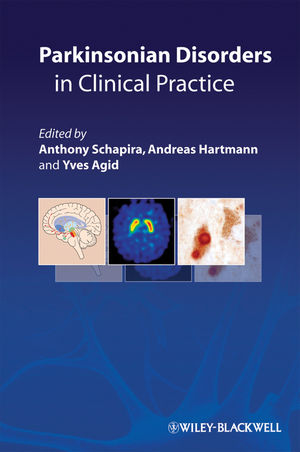Parkinsonian Disorders in Clinical PracticeISBN: 978-1-4051-9601-7
Paperback
208 pages
May 2009, Wiley-Blackwell
 |
||||||
Introduction.
1 What is Parkinson’s disease? From pathophysiology to symptoms (Andreas Hartmann, Yves Agid, Anthony Schapira).
I. Pathophysiology of Parkinson’s disease.
1. Dysfunctions of the main neuronal pathways in Parkinson’s disease.
a. An overview of neuronal systems affected in Parkinson’s disease.
b. Dopaminergic neurons.
c. Non-dopaminergic neurons.
2. Consequences of dopaminergic neuronal lesions on basal ganglia circuits.
a. The dopaminergic nigrostriatal system: pre- and postsynaptic compensatory mechanisms.
b. Pathologic alterations of nigrostriatal circuits in Parkinson’s disease.
3. Histopathology of Parkinson’s disease.
4. The etiopathogenesis of Parkinson’s disease.
a. The genetics of Parkinson’s disease: any clues for the sporadic forms?
b. Relevant environmental factors: focus on mitochondria.
c. Mechanisms of cell death in Parkinson’s disease: therapeutic implications.
5. Conclusions.
a. Parkinson’s disease or Parkinson’s syndromes?
b. What Parkinson’s disease is not.
II. Clinical features of Parkinson’s disease.
1. Motor symptoms.
2. Non-motor symptoms.
a. Depression.
b. Apathy.
c. Cognitive impairment.
d. Sleep.
e. Autonomic dysfunction.
f. Sensory symptoms.
3. The different forms of Parkinson’s disease: relevance for prognosis.
4. The differential diagnosis of Parkinson’s disease.
5. Treatment-related symptoms.
a. Motor complications.
b. Non-motor complications.
2 Treatment of Parkinson’s disease (Anthony Schapira, Andreas Hartmann, Yves Agid).
I. Antiparkinsonian agents.
1. Levodopa.
2. COMT inhibitors.
3. Dopamine agonists.
4. Monoamine oxidase B inhibitors.
5. Other drugs.
II. Medical management.
1. Initiation of treatment.
2. Maintenance of treatment (Fig. 2.7).
3. Motor complications.
4. Management of non-motor complications.
III. Non-medical management.
1. Surgery.
2. Destructive lesions.
3. Cell therapy.
4. Growth factors.
IV. Neuroprotection.
1. MAO-B inhibitors.
2. Dopamine agonists.
3. Coenzyme Q.
4. Creatine.
5. Antiapoptotic drugs.
V. Conclusion.
3 Case studies.
Case studies—diagnostic index.
Index.



